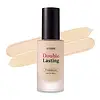What's inside
What's inside
 Key Ingredients
Key Ingredients

 Benefits
Benefits

 Concerns
Concerns

 Ingredients Side-by-side
Ingredients Side-by-side

Sorbitan Sesquioleate
EmulsifyingCetyl PEG/PPG-10/1 Dimethicone
EmulsifyingPentaerythrityl Tetraisostearate
EmollientAscorbic Acid
AntioxidantDimethicone
EmollientPhenyl Methicone
EmollientCamellia Japonica Seed Oil
EmollientIsononyl Isononanoate
EmollientSqualane
EmollientPrunus Persica Flower Extract
MoisturisingCamellia Sinensis Leaf Extract
AntimicrobialTalc
AbrasiveSilica
AbrasiveCyclopentasiloxane
EmollientOctyldodecanol
EmollientWater
Skin ConditioningGlycerin
HumectantTocopherol
AntioxidantTitanium Dioxide
Cosmetic ColorantSodium Chloride
MaskingCI 77491
Cosmetic ColorantCI 77492
Cosmetic ColorantSorbitan Sesquioleate, Cetyl PEG/PPG-10/1 Dimethicone, Pentaerythrityl Tetraisostearate, Ascorbic Acid, Dimethicone, Phenyl Methicone, Camellia Japonica Seed Oil, Isononyl Isononanoate, Squalane, Prunus Persica Flower Extract, Camellia Sinensis Leaf Extract, Talc, Silica, Cyclopentasiloxane, Octyldodecanol, Water, Glycerin, Tocopherol, Titanium Dioxide, Sodium Chloride, CI 77491, CI 77492
Water
Skin ConditioningCyclopentasiloxane
EmollientCI 77891
Cosmetic ColorantTrimethylsiloxysilicate
EmollientCyclohexasiloxane
EmollientTitanium Dioxide
Cosmetic ColorantCaprylyl Methicone
Skin ConditioningButylene Glycol
HumectantPEG/PPG-18/18 Dimethicone
EmulsifyingCI 77492
Cosmetic ColorantMica
Cosmetic ColorantSodium Chloride
MaskingDimethicone/Vinyl Dimethicone Crosspolymer
Skin ConditioningDisteardimonium Hectorite
StabilisingPolymethylsilsesquioxane
PEG-10 Dimethicone
Skin ConditioningAlumina
AbrasiveAluminum Hydroxide
EmollientPentylene Glycol
Skin Conditioning1,2-Hexanediol
Skin ConditioningCI 77491
Cosmetic ColorantTriethoxycaprylylsilane
Parfum
MaskingCaprylyl Glycol
EmollientGlyceryl Caprylate
EmollientCI 77499
Cosmetic ColorantSimethicone
EmollientXanthan Gum
EmulsifyingDisodium EDTA
Methicone
EmollientBoron Nitride
AbsorbentMethyl Methacrylate Crosspolymer
Tin Oxide
AbrasiveWater, Cyclopentasiloxane, CI 77891, Trimethylsiloxysilicate, Cyclohexasiloxane, Titanium Dioxide, Caprylyl Methicone, Butylene Glycol, PEG/PPG-18/18 Dimethicone, CI 77492, Mica, Sodium Chloride, Dimethicone/Vinyl Dimethicone Crosspolymer, Disteardimonium Hectorite, Polymethylsilsesquioxane, PEG-10 Dimethicone, Alumina, Aluminum Hydroxide, Pentylene Glycol, 1,2-Hexanediol, CI 77491, Triethoxycaprylylsilane, Parfum, Caprylyl Glycol, Glyceryl Caprylate, CI 77499, Simethicone, Xanthan Gum, Disodium EDTA, Methicone, Boron Nitride, Methyl Methacrylate Crosspolymer, Tin Oxide
Ingredients Explained
These ingredients are found in both products.
Ingredients higher up in an ingredient list are typically present in a larger amount.
Ci 77491 is also hydrated iron III oxide. It's sole purpose is to give a red/pink hue to products.
Iron III oxides are classified as inorganic chemicals for coloring.
Synthetically created Ci 77491 is considered safer than those naturally found. This is because the synthetically created version may contain less impurities. Iron oxides are generally non-toxic and non-allergenic.
Learn more about CI 77491Ci 77492 is also hydrated iron III oxide. It's sole purpose is to give a yellow hue to products.
Iron III oxides are classified as inorganic chemicals for coloring.
Synthetically created Ci 77492 is considered safer than those naturally found. This is because the synthetically created version may contain less impurities. Iron oxides are generally non-toxic and non-allergenic.
Learn more about CI 77492Cyclopentasiloxane, or D5, is a silicone used to improve texture of products and trap moisture.
D5 is considered lightweight and volatile. Volatile means it evaporates quickly after application. Once evaporated, D5 leaves a thin barrier that helps keep skin hydrated.
It is also an emollient. Emollients help soften the skin and prevent water loss. Silicones create a silky texture in products. D5 helps other ingredients become more spreadable.
Studies show D5 is safe to use in skincare products. We recommend speaking with a skincare professional if you have concerns.
Learn more about CyclopentasiloxaneChances are, you eat sodium chloride every day. Sodium Chloride is also known as table salt.
This ingredient has many purposes in skincare: thickener, emulsifier, and exfoliator.
You'll most likely find this ingredient in cleansers where it is used to create a gel-like texture. As an emulsifier, it also prevents ingredients from separating.
There is much debate on whether this ingredient is comedogenic. The short answer - comedogenic ratings don't tell the whole story. Learn more about comegodenic ratings here.
The concensus about this ingredient causing acne seems to be divided. Research is needed to understand if this ingredient does cause acne.
Scrubs may use salt as the primary exfoliating ingredient.
Learn more about Sodium ChlorideTitanium dioxide is a mineral UV filter widely used in sunscreens and cosmetics.
It is one of only two UV filters officially classified as “mineral” by regulatory agencies, the other being zinc oxide.
Titanium dioxide provides broad-spectrum protection mostly in the UVB and UVAII range, with some protection in the UVAI range.
While its UVA protection isn’t as strong as zinc oxide’s, the difference is minor.
A common myth is that mineral UV filters reflect UV light. However, modern research shows titanium dioxide absorbs UV radiation like chemical filters (~95% absorption & 5% reflection).
Thanks to its non-irritating nature, titanium dioxide is suitable for sensitive, acne-prone, or redness-prone skin. It is unlikely to cause "eye sting" like other sunscreen ingredients.
A major drawback of this ingredient is its white cast and thick texture. This is why mineral sunscreens often leave a white cast and are less cosmetically elegant than chemical/hybrid sunscreens.
To improve white cast and spreadability, micronized or nano-sized titanium dioxide is often used.
There are ongoing concerns surrounding nano-titanium oxide's impact on marine ecosystems.
There is no conclusive evidence that any form of titanium oxide (or any other sunscreen ingredients) will cause harm to marine ecosystems or coral reefs. The science is still developing but many consumers are keeping a close eye on this issue.
Please note, many destinations have reef-safety sunscreen rules. For instance, the U.S. Virgin Islands advises all visitors to use non-nano mineral sunscreens.
Nano mineral sunscreens once raised safety concerns about absorption into skin.
Extensive research has shown that they do not penetrate healthy or damaged skin; they remain safely on the surface and the top layer of dead skin (stratum corneum).
You'll likely find titanium dioxide bundled with alumina, silica, or dimethicone. These ingredients help make titanium dioxide highly photostable; this prevents it from interacting with other formula components under UV light.
Learn more about Titanium DioxideWater. It's the most common cosmetic ingredient of all. You'll usually see it at the top of ingredient lists, meaning that it makes up the largest part of the product.
So why is it so popular? Water most often acts as a solvent - this means that it helps dissolve other ingredients into the formulation.
You'll also recognize water as that liquid we all need to stay alive. If you see this, drink a glass of water. Stay hydrated!
Learn more about Water